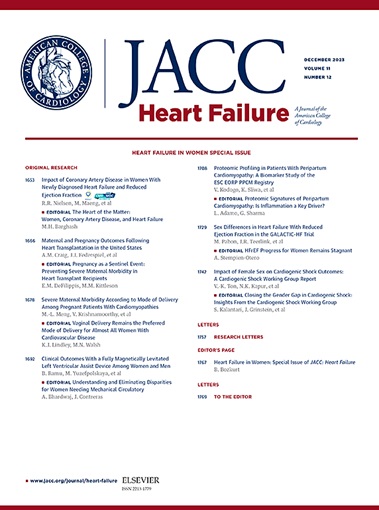社区医疗系统中心力衰竭患者住院期间使用指南指导下的医疗疗法的情况。
IF 10.3
1区 医学
Q1 CARDIAC & CARDIOVASCULAR SYSTEMS
引用次数: 0
摘要
背景射血分数降低型心力衰竭(HFrEF)的指导性医疗疗法(GDMT)仍未得到充分利用。急性心力衰竭(HF)住院是快速启动循证药物治疗的关键时机。然而,出院时使用 GDMT 的数据大多来自国家质量改进登记处。目的:本研究旨在描述社区医疗系统中 HF 住院患者使用 GDMT 的当代模式。方法:作者在美国的一个数据库中识别了 2016 年至 2022 年的 HF 住院患者,该数据库汇总了来自 30 多个医疗系统的去标识化电子健康记录数据。报告了符合条件的 HFrEF 患者使用 GDMT 的住院率和出院率。结果在 13729 名 HFrEF 患者中,共发现了 20387 例 HF 住院病例。在符合条件的住院患者中,分别有 70%、86% 和 37% 使用了肾素-血管紧张素系统抑制剂、β-受体阻滞剂和矿皮质激素受体拮抗剂。在符合条件的住院患者中,分别有 17% 和 8% 使用了血管紧张素受体-奈普利酶抑制剂和钠-葡萄糖共转运体 2 抑制剂。出院时的 GDMT 使用率较低。26%的住院患者接受了三联/四联疗法,出院时这一比例降至14%。出院前停用 GDMT 与住院期间低血压、高钾血症和肾功能恶化有关,但 43%-57% 的患者没有医疗禁忌症。在调整后的分析中,与不太全面的 GDMT 相比,使用 3 种或更多种 GDMT 与 90 天全因死亡和 HF 再入院的发生率较低有关。高停药率强调了住院和出院后优化 GDMT 使用策略的需求尚未得到满足。本文章由计算机程序翻译,如有差异,请以英文原文为准。
Inpatient Use of Guideline-Directed Medical Therapy During Heart Failure Hospitalizations Among Community-Based Health Systems
Background
Guideline-directed medical therapy (GDMT) for heart failure with reduced ejection fraction (HFrEF) remains underused. Acute heart failure (HF) hospitalization represents a critical opportunity for rapid initiation of evidence-based medications. However, data on GDMT use at discharge are mostly derived from national quality improvement registries.
Objectives
This study aimed to describe contemporary GDMT use patterns across HF hospitalizations at community-based health systems.
Methods
The authors identified HF hospitalizations from 2016 to 2022 in a U.S. database aggregating deidentified electronic health record data from more than 30 health systems. In-hospital and discharge rates of GDMT use were reported for eligible HFrEF patients. Factors associated with inpatient GDMT use and predischarge discontinuation were evaluated with the use of multivariable models.
Results
A total of 20,387 HF hospitalizations among 13,729 HFrEF patients were identified. Renin-angiotensin system inhibitors, beta-blockers, and mineralocorticoid receptor antagonists were administered during 70%, 86%, and 37% of eligible hospitalizations, respectively. Angiotensin receptor–neprilysin inhibitors and sodium-glucose cotransporter 2 inhibitors were used in 17% and 8% of eligible hospitalizations, respectively. Discharge GDMT rates were low. Triple/quadruple therapy was administered in 26% of hospitalizations, falling to 14% on discharge. Predischarge GDMT discontinuations were associated with inpatient hypotension, hyperkalemia, and worsening renal function, but 43%-57% had no medical contraindications. In adjusted analyses, use of 3 or more GDMT classes was associated with fewer 90-day all-cause deaths and HF readmissions compared with less comprehensive GDMT.
Conclusions
Inpatient GDMT use in a national analysis of HF hospitalizations was lower than reported in quality improvement registries. High discontinuation rates emphasize an unmet need for inpatient and postdischarge strategies to optimize GDMT use.
求助全文
通过发布文献求助,成功后即可免费获取论文全文。
去求助
来源期刊

JACC. Heart failure
CARDIAC & CARDIOVASCULAR SYSTEMS-
CiteScore
21.20
自引率
2.30%
发文量
164
期刊介绍:
JACC: Heart Failure publishes crucial findings on the pathophysiology, diagnosis, treatment, and care of heart failure patients. The goal is to enhance understanding through timely scientific communication on disease, clinical trials, outcomes, and therapeutic advances. The Journal fosters interdisciplinary connections with neuroscience, pulmonary medicine, nephrology, electrophysiology, and surgery related to heart failure. It also covers articles on pharmacogenetics, biomarkers, and metabolomics.
 求助内容:
求助内容: 应助结果提醒方式:
应助结果提醒方式:


